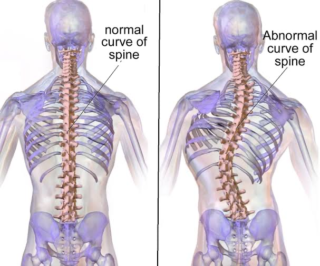CONDITIONS
Medical Conditions we treat:
- Musculoskeletal Conditions
Joints & Bones
Frozen Shoulder (Adhesive Capsulitis)
Bursitis
Dislocated Shoulder
Post Surgical Rehabilitation
Knee Pain
Osteoarthritis
Condramalacia Patella
Joint Stiffness
Neck & Spine
Neck Pain & Stiffness
Spondylitis
Low Back Pain
Sciatica
Degenerative Disc Disease(DDD)
Herniated Discs(Bulging Discs)/Slipped Disc
Spondylosis
Scoliosis
Piriformis Syndrome
Posture problems
Muscles
Spasm
Fibromyalgia
Rotator Cuff Injuries
De Quervain’s tenosynovitis
Trigger Finger
- Neurological conditions
- Sports injury conditions
Scoliosis
A normal spine, when viewed from behind, looks straight. But a spine affected by scoliosis shows a side-to-side curvature, with the spine looking like an “S” or “C.” The back bones (vertebrae) may also be rotated. This makes it look like the person is leaning to one side. Scoliosis is defined as a curvature of the spine measuring 10° or greater.
Scoliosis is not due to poor posture.
Spinal curvature from scoliosis may occur on the right, left, or both sides of the spine. Both the middle (thoracic) and lower (lumbar) spine may be affected by scoliosis.

What causes scoliosis?
In most cases, the cause of scoliosis is not known. This is called idiopathic scoliosis. In other cases, scoliosis may be caused by a breakdown of the spinal discs. This can occur with arthritis or osteoporosis. Or it may be a hereditary condition that runs in families.
The abnormal curves of the spine are defined according to their cause, including:
Nonstructural scoliosis. This is also called functional scoliosis. In this condition, a normal spine is curved due to 1 or more problems. For example, the leg lengths may be different. Or there may be an inflammatory problem. This type of scoliosis is often short-term. It goes away when the underlying problem is treated.
Structural scoliosis. The possible causes of structural scoliosis include:
- Unknown (idiopathic scoliosis)
- Disease that is neuromuscular, metabolic, rheumatoid, or other type
- Birth defect
- Injury
- Infection
- Abnormal growth
What are the symptoms of scoliosis?
These are the most common symptoms of scoliosis:
- Difference in shoulder height
- Head is off-center from the rest of the body
- Difference in hip height or position
- Difference in shoulder blade height or position
- When standing straight, difference in the way the arms hang beside the body
- When bending forward, the sides of the back look different in height
Get medical care right away if you have back pain, leg pain, or changes in bowel and bladder habits. These are not often seen with idiopathic scoliosis.
The symptoms of scoliosis may look like other health problems. Always see your healthcare provider for a diagnosis.
How is scoliosis diagnosed?
A healthcare provider will ask about your health history. He or she will give you a physical exam. You will have X-rays. These are the main tool for diagnosing scoliosis. The healthcare provider measures the degree of spinal curvature on the X-ray.
Other tests may be done for nonidiopathic curvatures, abnormal curve patterns, or congenital scoliosis. These include:
MRI. MRI uses a combination of large magnets and a computer to produce detailed images of organs and structures within the body.
CT scan. A CT scan uses X-rays and computer technology to make horizontal, or axial, images (often called slices) of the body. A CT scan shows detailed images of any part of the body, including the bones, muscles, fat, and organs. CT scans are more detailed than general X-rays.
Early detection of scoliosis is most important for successful treatment.

